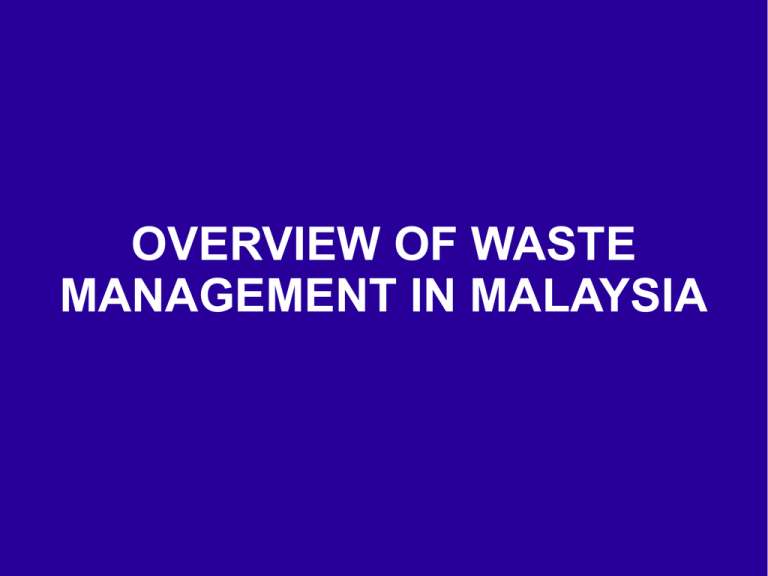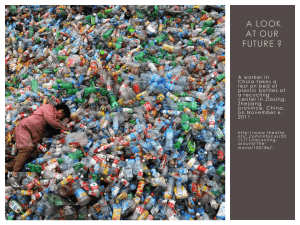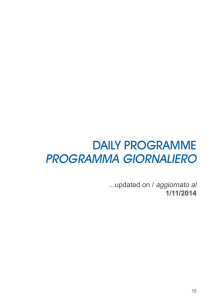Overview Waste Manag..
advertisement

OVERVIEW OF WASTE MANAGEMENT IN MALAYSIA WASTE COMPOSITION AND RECYCLING RATE 2005 2012 26,600,000 28,300,300 19,000++ 33,000 0.8kg/day/person 1.1kg/day/person Food Waste 45 44.5 Plastic 24 13.2 Diapers - 12.1 Paper 7 8.5 Garden Waste - 5.8 Population Waste Generation (tonne/day) Generation rate Waste composition(%) Glass 3.3 Textile 3.1 Others Recycling Rate (%) 24 5 9.5 10.5 33,000 ton/day - what does it mean? 1 day – 0.183333 km square of 1m high 30 days – 5.5 km square 44 months – Kuala Lumpur of 243 km square, full with 1 m high solid waste RECYCLING – ECONOMIC POTENTIAL WASTE TO WEALTH Composition Percentage (%) Amount (tones/year) Market price (RM/kg) Values (Million, RM) Papers 17.1 1,026,000 0.20 205.2 Plastics 9.1 546,000 0.30 163.8 Glass 3.7 222,000 0.05 11.1 Aluminium 0.4 24,000 2.00 48.0 Scrap Metals 1.6 96,000 0.50 48.0 Other nonrecyclable 68.1 4,086,000 - - Total 100.0 6,000,000 - 476.1 Note: 1) Waste composition data obtained from MHLG (2005) 2) Total waste generation was estimated at 6 million tones per year 3) Average market prices were based on prices at recycling centre as at September 2005; actual prices at recyclable agents, middleman and end buyers (industries) are usually much higher 3R PROVISION IN THE SOLID WASTE AND PUBLIC CLEANSING MANAGEMENT ACT (ACT 672) PART X REDUCTION AND RECOVERY OF CONTROLLED SOLID WASTE 101. Reduction, reuse and recycling 102. Take back system and deposit refund system LAB PENGURUSAN SISA PEPEJAL PEMANDU LAB PENGURUSAN SISA PEPEJAL PEMANDU WASTE STREAM LIFE CYCLE DESIGN PRODUCTION DISTRIBUTION & RETAILS HOUSEHOLD WASTE COMMERCIAL / INSTITUTIONAL WASTE INDUSTRIAL WASTE CONSTRUCTION & DEMOLITION SPECIAL WASTE CONSUMER STORAGE COLLECTION TRANSFER /HAULAGE TREATMENT DISPOSAL Sanitary landfill Privatisation Improved service Free waste bin ENVIROMENT SOCIAL ECONOMY SUSTAINABILITY 2 Transfer station One RDF plant WtE Small incinerator KL incinerator LFG to energy WASTE STREAM LIFE CYCLE DESIGN -Recyclability -Recycle content -Policy PRODUCTION -Extended producer Responsibility -Take back -Deposit refund -ELV -Waste exchange DISTRIBUTION & RETAILS HOUSEHOLD WASTE COMMERCIAL / INSTITUTIONAL WASTE INDUSTRIAL WASTE CONSTRUCTION & DEMOLITION SPECIAL WASTE CONSUMER STORAGE COLLECTION TRANSFER /HAULAGE TREATMENT DISPOSAL Sanitary landfill -Packaging -Policy -Packaging tax -Public participation -Home composting -Home AD -PAYT Separation at source Privatisation Improved service Free waste bin 2 Transfer station One RDF plant WtE Small incinerator KL incinerator LFG to energy Landfill tax ENVIROMENT SOCIAL ECONOMY SUSTAINABILITY THE OBJECTIVE To formulate an action plan for Comprehensive, Integrated and Sustainable solid waste management in Malaysia HOUSEHOLD WASTE COMPOSITION 10.57 2.73 1.31 12.14 51.62 8.45 Organic Waste Plastic Paper Diapers Household Hazardous Waste Metal Others 13.18 WASTE FROM HOUSEHOLD & SIMILAR WASTE What we have improved? Reliable collection Free waste bin Regular monitoring (KPI) Effective public complaint system - 2 x per week – kitchen waste + residual waste - 1 x per week - recyclable + bulky + garden waste - New collection vehicle – EN1505 - No spillage (waste & leachate) What are the pending issues ? Increase in waste generation- rate & volume Segregation at source Hazardous household waste (1.3%) (Chemical and biological hazard) WEE – hazardous (DOE) Bulky waste Garden waste 53 / 99 PBTs Waste discarded – 10 to 2500 ton/day FOOD AND ORGANIC WASTE 45% of waste discarded, 15,000 ton/day Storage – enclosed (animal, vector), decompose High collection cost – special compactor, regular collection Contribute to greenhouse gasses (GHG) Produce leachate – pollution, LTP (high CAPEX & OPEX) Low calorific value (but nutrient rich waste) Generators – house, food court, restaurant, hotel, market, training institution, food industry (expired products), event, etc. Treatment of the food wastes - extremely limited CONSTRUCTION AND DEMOLITION WASTE COMPOSITION Percentage (%) Concrete Metal Bricks Plastic Woods Others 12.3 9.6 6.5 0.4 69.1 2 CONSTRUCTION AND DEMOLITION (C&D) WASTE ISSUES The Star Newspaper, 2011 The Star Newspaper, 2012 CONSTRUCTION AND DEMOLITION WASTE ISSUE Main issue – illegal dumping 85% recyclable Secondary construction materials Pilot project – Worldwide Inert Waste Landfill Kampung Sungai Kertas, Gombak PLASTIC IN LANDFILL PLASTICS,TETRA PAK, DIAPERS Highest in numbers - 15% Very noticeable in landfill, non- degradable Used in most consumer products Plastic resin used - 3,087,765 ton/year or 8459 ton/day PE (985,000 ton/yr), PP(450,000 ton/yr), PET(178,000 ton/yr), PS (215,000 ton/yr), ABS (170,000 ton/yr) PVC (350,000 ton/yr) - dioxin Low Recycling rate- 2.5%: 109 ton/day (recycle) vs. 4,300 ton/day (discarded) PLASTIC APPLICATION Percentage (%) Packaging 42 Electrical and Electronic 26 Householde 10 Automotive Construction 11 Agriculture 7 Others 2 2 Potential – recycle industry (W2W), high Calorific Value (WtE) MPMA participation & contribution Brand owner participation & contribution CONSUMER GOODS All waste except food waste, plastic, C&D, garden waste E-Waste (WEE), Furniture, Textile, Leather goods, Rubber, Glass, Household Hazardous Waste (HHW) – paint, thinners, kitchen cleaners and End of Life Vehicle (ELV) Disposed to landfill Lack of recycling facilities Extended Producer Responsibility (EPR) Take back, deposit refund, recycling material content WASTE MANAGEMENT IN 11th MALAYSIA PLAN Rancangan Malaysia Kesebelas (RMKe-11) Dokumen RMKe-11 terdiri daripada enam (6) teras tama Teras 1 – Merekayasa Pertumbuhan Ekonomi Teras 2 – Memperkasa Pemacu Pertumbuhan Teras 3 – Memanfaat Bakat Teras 4 – Mengarusperdana Pengurusan Alam Sekitar dan Sumber Asli Teras 5 – Memperkukuh Pembangunan Inklusif Teras 6 – Meningkat Kesejahteraan Rakyat Waste Management in 11th Malaysia Plan Implementation of comprehensive, integrated & sustainable waste management Policy Legal aspect – implementation of Act 672 Strengthening the institutions Capacity building etc. Defining Integrated WM Integrated solid waste management strategic approach to sustainable management covering all sources and all aspects, generation, segregation, transfer, sorting, treatment, recovery and disposal in an integrated manner, with an emphasis on maximizing resource use efficiency. Defining Sustainable WM ENVIRONMENT by reducing or eliminating adverse impacts on the local and general environment and minimizing resource extraction by reducing the budget needed for solid waste collection services,ECONOMIC treatment, and disposal by improving economic efficiency, especially in resource extraction and use By creation of markets for the recyclables public participation in 3R activity by delivering more attractive SOCIAL and pleasant human settlements better social amenity, sources of employment and potentially a route out of poverty Source: Guidelines for National Waste Management Strategies - Moving from challenge to opportunities United Nations Institute for Training and Research Integrated Sustainable Waste Management Plan Model STAKEHOLDERS Local Authorities NGOs / CBOs Service users Industries & Commercial Private informal sector Private formal sector Donor agencies WASTE SYSTEM ELEMENTS Generation & Separation Collection Reduction Reduction Re-use ASPECTS Technical Environmental / Health Financial / Economic Socio-cultural Institutional Policy / Legal/ Political Transfer & Transport Treatment & Disposal Recycling Recovery Process time Sustainability Producers & Retailers SCPI SCPI Source: Integrated Solid Waste Management Mushtaq Ahemd MEMON International Environmental Technology Centre Benefits of ISWM Cleaner and safe neighbourhoods Higher resource use efficiency Resource augmentation Savings in waste management costs due to reduced levels of final waste disposal Better business opportunities and economic growth Local ownership & responsibilities / participation Source: Integrated Solid Waste Management Mushtaq Ahemd MEMON International Environmental Technology Centre Process to Develop ISWM 1 3 Waste Characterization & Quantification Future Trends Targets for ISWM 4 2 Prevailing Solid Waste Management System & Gaps therein Constraints & Stakeholders' Concerns Integrated Sustainable Waste Management Plan (Management System including Technical, Policy & Voluntary aspects) Source: Integrated Solid Waste Management Mushtaq Ahemd MEMON International Environmental Technology Centre Committees Advisory Committee To provide input and guidance concerning aspect related to their field of expertise An independent committee member Steering Committee To direct and monitor the ISWM planning process The End Thank you for your attention WASTE MANAGEMENT ISSUE PLASTICS Teras 4 dalam RMKe-11 Pengurusan sisa: satu daripada enam isu utama yang terdapat dalam TWG Biodiversiti, Pengurusan Alam Sekitar dan Perubahan Iklam kurang diberi penekanan dan sering dilihat secara berasingan dalam dokumen-dokumen Rancangan Malaysia sebelum ini. lebih menyeluruh dan bersepadu diberi penekanan dalam penyediaan kertas strategi Isu e-waste di Malaysia Perundangan sedia ada digubal hanya untuk digunapakai di sektor industri dan kurang sesuai untuk pengurusan sisa bagi isi rumah JAS - penyediaan rangka pengurusan untuk mengatasinya mengenalpasti pendekatan berkesan bagi menggalakkan masyarakat menguruskan ewaste


